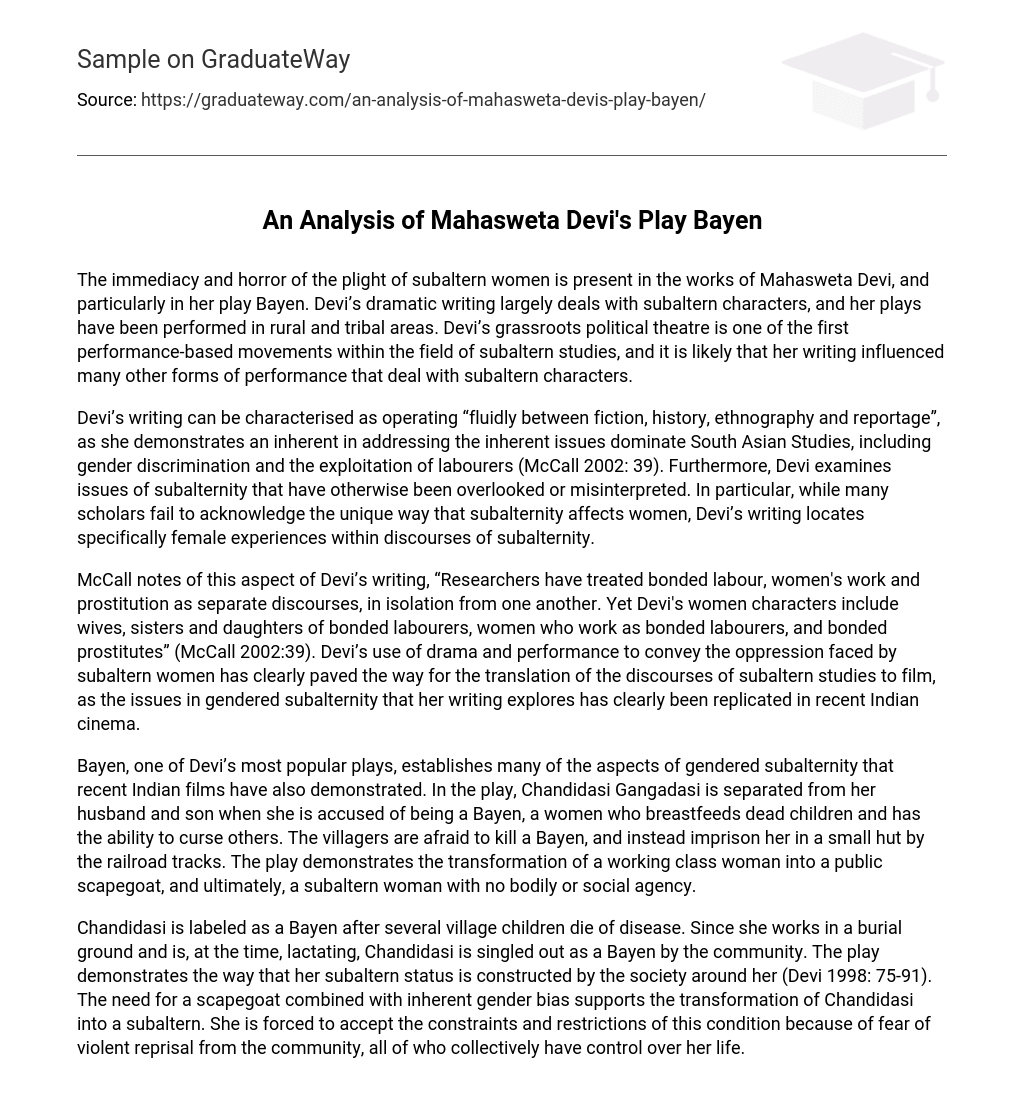The immediacy and horror of the plight of subaltern women is present in the works of Mahasweta Devi, and particularly in her play Bayen. Devi’s dramatic writing largely deals with subaltern characters, and her plays have been performed in rural and tribal areas. Devi’s grassroots political theatre is one of the first performance-based movements within the field of subaltern studies, and it is likely that her writing influenced many other forms of performance that deal with subaltern characters.
Devi’s writing can be characterised as operating “fluidly between fiction, history, ethnography and reportage”, as she demonstrates an inherent in addressing the inherent issues dominate South Asian Studies, including gender discrimination and the exploitation of labourers (McCall 2002: 39). Furthermore, Devi examines issues of subalternity that have otherwise been overlooked or misinterpreted. In particular, while many scholars fail to acknowledge the unique way that subalternity affects women, Devi’s writing locates specifically female experiences within discourses of subalternity.
McCall notes of this aspect of Devi’s writing, “Researchers have treated bonded labour, women’s work and prostitution as separate discourses, in isolation from one another. Yet Devi’s women characters include wives, sisters and daughters of bonded labourers, women who work as bonded labourers, and bonded prostitutes” (McCall 2002:39). Devi’s use of drama and performance to convey the oppression faced by subaltern women has clearly paved the way for the translation of the discourses of subaltern studies to film, as the issues in gendered subalternity that her writing explores has clearly been replicated in recent Indian cinema.
Bayen, one of Devi’s most popular plays, establishes many of the aspects of gendered subalternity that recent Indian films have also demonstrated. In the play, Chandidasi Gangadasi is separated from her husband and son when she is accused of being a Bayen, a women who breastfeeds dead children and has the ability to curse others. The villagers are afraid to kill a Bayen, and instead imprison her in a small hut by the railroad tracks. The play demonstrates the transformation of a working class woman into a public scapegoat, and ultimately, a subaltern woman with no bodily or social agency.
Chandidasi is labeled as a Bayen after several village children die of disease. Since she works in a burial ground and is, at the time, lactating, Chandidasi is singled out as a Bayen by the community. The play demonstrates the way that her subaltern status is constructed by the society around her (Devi 1998: 75-91). The need for a scapegoat combined with inherent gender bias supports the transformation of Chandidasi into a subaltern. She is forced to accept the constraints and restrictions of this condition because of fear of violent reprisal from the community, all of who collectively have control over her life.
Her subaltern status denies her access to her child, and thus, her inability to fulfil the role of mother further preserves her position as a subaltern. It is only after her death at the end of the play, when Bhagirath, her son publicly decries her treatment that the villagers are willing to accept that she is not a Bayen. This affirmation of her motherhood posthumously removes her status of Bayen, but of course, at this point it is too late to have any significance. Despite the fact that she is dead, this reaffirms that the denial of Chandidasi’s motherhood is fundamental to the construction of her subaltern status.
Chandidasi is forced to stay in this condition because of the surveillance of the village, which is demonstrative of Foucault’s discourse on panoptic discipline. Focault argued that deviation from expectations of social norms is monitored through the understanding that one is constantly subject to the observation of those around them, which he argues mimics the architectural design of a panoptic prison (Foucault 1975). Chandidasi is repeatedly reminded not set her eyes upon anyone in the village, as she supposedly has the “evil eye”. Her inability to stare upon the village, as they constantly monitor her exemplifies this idea of punishment.
She is constantly subject to the gaze of those who seek to control her, yet she has no means of knowing when she is being monitored and whether any violation of her imprisonment will have any repercussions. Devi writes that Chandidasi turns her back to her ex-husband when he enters the stage, as she has been conditioned to ensure that she does not set her eyes upon him or their child (Devi 1998: 76). This constant concern with visual contact denotes that subalternity is enforced through the village’s panoptic discipline, a trend that repeatedly occurs throughout other performance-based discourses on subalternity.





